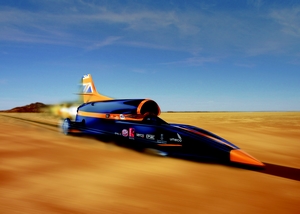Breaking the Sound Barrier with HPC
In 1997, a car called ThrustSSC became the first car to break the sound barrier as it blasted across the Arizona desert, establishing the current land-speed record of 763 mph.
 Now, several members of the ThrustSSC team, including project director Richard Noble and driver Andy Green, have come together to set a new land-speed record: 1,000 mph—over 200 mph more than the speed of sound.
Now, several members of the ThrustSSC team, including project director Richard Noble and driver Andy Green, have come together to set a new land-speed record: 1,000 mph—over 200 mph more than the speed of sound.
To help the team achieve its goal with this new supersonic car (called the “Bloodhound”), computational fluid dynamics (CFD) engineer Ben Evans is making computer simulations an essential part of the design process.
Because the car can't be tested at speed until the team is on-site at the Hakskeen Pan in South Africa in 2014, computer simulations will be responsible for every aspect of optimizing the car's design: from helping it reach its target speed to keeping the wheels on the ground.
And as you might imagine, the CFD simulations necessary for a project of this type have to be highly complex—not only does this have to be the most aerodynamic supersonic car ever built, engineers must also operate with the driver's safety in mind.
“There are lots of things we need to understand about the aerodynamics of the vehicle to make sure that it's safe; we need to understand where the loads are distributed across the vehicle, we need to understand if we've got the drag (the resistive force of the air that will be pushing on the car) as low as it can be so that our engines can propel us to the speeds we are going for; and to do the modeling to understand all of that requires some incredibly complex calculations to process massive amounts of data,” said Evans.
The only systems capable of delivering such complex and accurate simulations are high performance computers, which led the team to HPC Wales. There, the team has access to HPC resources that not only give them more accurate data about how the car will run, but they also are able to run more simulations in a given amount of time, which means more revisions that will ultimately make for a better car.
According to Evans, these simulations have helped the team to understand the vehicle better than they had ever hoped to.
In an effort to inspire the next generation of scientists and engineers, the Bloodhound project is making all of its research and design material available to the public.
And inspiration isn't the only perk the project will be lending the engineering community.
“We're not all going to be driving around in 1,000 mph cars in the near future, but like any ambitious engineering project like this, some of the technologies we develop specifically for this we will be able to spin out into other more general applications,” said Evans.
Evans further explained, “We've developed techniques for simulating dust and particle entrainment into the flow around Bloodhound and we're now thinking about how we can apply that technology to things like high-speed trains and aircraft landing on wet runways, just as examples.”
Full story at HPC Wales










